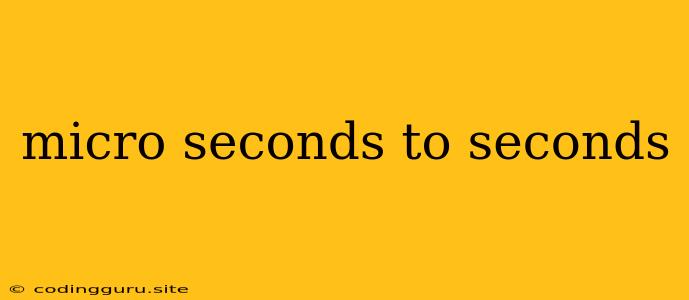Converting Microseconds to Seconds: A Comprehensive Guide
Working with time measurements can be tricky, especially when dealing with different units like microseconds and seconds. Microseconds are incredibly small units of time, often used in high-precision applications or scenarios where measuring time accurately is paramount. Understanding how to convert microseconds to seconds is essential for various tasks, from data analysis to programming.
This guide will explore the fundamental concepts of microseconds and seconds, delve into the conversion process, provide practical examples, and equip you with the tools to confidently perform conversions in various programming languages.
Understanding Microseconds and Seconds
Microseconds (µs) are a unit of time equal to one millionth of a second (1/1,000,000 second). This means that one second is equal to one million microseconds.
Seconds, on the other hand, are a more common unit of time, often used for measuring durations in everyday life.
The Conversion Formula
The conversion from microseconds to seconds is a simple division process:
Seconds = Microseconds / 1,000,000
Examples
Let's illustrate this conversion with some examples:
Example 1: Convert 5,000,000 microseconds to seconds.
Seconds = 5,000,000 µs / 1,000,000 = 5 seconds
Example 2: Convert 125,000 microseconds to seconds.
Seconds = 125,000 µs / 1,000,000 = 0.125 seconds
Example 3: Convert 2,500 microseconds to seconds.
Seconds = 2,500 µs / 1,000,000 = 0.0025 seconds
Programming Language Implementation
The conversion process is straightforward in most programming languages. Here are some common implementations:
Python:
microseconds = 5000000
seconds = microseconds / 1000000
print(f"{microseconds} microseconds is equal to {seconds} seconds")
JavaScript:
let microseconds = 5000000;
let seconds = microseconds / 1000000;
console.log(`${microseconds} microseconds is equal to ${seconds} seconds`);
Java:
long microseconds = 5000000;
double seconds = microseconds / 1000000.0;
System.out.println(microseconds + " microseconds is equal to " + seconds + " seconds");
Tips for Accurate Conversions
- Use the correct unit: Ensure you are working with microseconds (µs) before applying the conversion formula.
- Avoid rounding errors: When working with decimal values, consider using data types that handle floating-point numbers accurately to minimize rounding errors.
- Contextualize the conversion: The significance of the converted value depends on the context. A small duration in seconds might be a significant amount of time in microseconds.
Applications of Microseconds to Seconds Conversion
The conversion from microseconds to seconds is crucial in various applications, including:
- Performance analysis: Measuring the execution time of algorithms or programs in microseconds and converting them to seconds can help understand the performance efficiency.
- Network latency: Understanding network latency in milliseconds or microseconds is critical for optimizing network performance and ensuring smooth data transmission.
- Data processing: Many data analysis applications deal with time-series data, where converting timestamps from microseconds to seconds is essential for analysis and visualization.
- Sensor data: Sensors often capture data at high frequencies, generating readings in microseconds. Converting these readings to seconds is necessary for analyzing trends and patterns.
Conclusion
Converting microseconds to seconds is a fundamental process in many technical fields. By understanding the conversion formula, implementing it in programming languages, and applying it correctly, you can effectively work with different time units and achieve accurate time measurements. Remember to use the correct units, avoid rounding errors, and consider the context of your conversions to ensure you understand the significance of the results.
